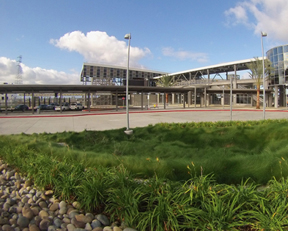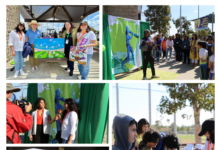
What does it take to construct a state-of-the-art, environmentally sustainable train station?
It was a long road to the March 25 grand opening, but BART, with its new Warm Springs/South Fremont Station, has done just that with a simple strategy: to “bake in” features that are best-practice for the environment from the very beginning.
A PERSONAL ENDEAVOR
“This project is quite a personal endeavor for our team,” said Paul Medved, Group and Project Manager for Warm Springs since 2000. “A mentality of sustainability is part of a culture that doesn’t just happen on its own.”
Warm Springs challenges the environmental impacts of traditional building styles and looks at energy efficiency, runoff water retention, effects on wildlife, and other environmental aspects in a whole new way.
The station’s spectacular visual aesthetic and artistic integration of color that changes with the rising and setting sun draw attention to the natural beauty of the area.
OPEN-CONCEPT LAYOUT
An open-concept design showcases Bay views to the West and undulating hills to the East. The hills are a green contrast to the blue sky in the rainy winter; the sun is strong in the spring and summer; and Bay breezes blow the wildflowers in the fall.
But the station has more than a pretty face. Its entire building process has been guided by principles of sustainable and accessible, human-centered design.
DRAINAGE BY DESIGN
In rainy seasons, the sweeping vistas at Warm Springs turn from dry brown to luscious green. Without the right ratio of permeable to non-permeable surfaces (landscape to hardscape), drainage can be a problem.
Warm Springs has features known as bioswales with native and drought-tolerant landscaping surrounding the 2,000-space parking lot with native Juncus shade grass under solar canopies. The main grand bioswale provides a lush bed of sun-loving fescue grasses beside where buses come in and out of the station.
These grasses, pebbles, shrubs and swan hill olive trees soak up and filter water, as part of a drainage system that could otherwise intrude into car, bike, and bus paths, while also removing pollutants that the rain can carry into the Bay.
The plants require minimal watering in the summertime since they are adjusted to the local climate.
It’s a somewhat Suessian sight – the bioswale thatches and drought-tolerant palm foliage bring to mind the ecosystem of Truffula trees and dense tufts housing creatures like Bar-ba-loots, Swomee-Swans and Humming-Fish in Theodore Geisel’s classic environmental fable, The Lorax.
Raquel Crites is BART Contributing Writer and Photographer
RAQUEL CRITES






